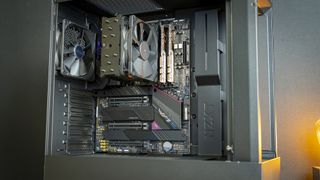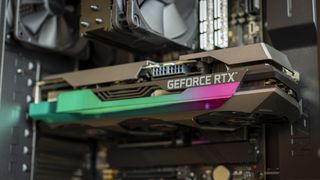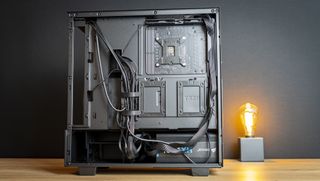Why you can trust Tom's Hardware
We are using the following system for our case test bed:
| CPU | Intel Core i9-11900K |
| Motherboard | Asus ROG Strix Z590-E Gaming |
| Memory | G.Skill Trident Z Royal 3600 MHz, 16GB (2x 8 GB) |
| Graphics | Zotac RTX 3080 Ti Amp! Holo |
| CPU Cooling | Noctua NH-U12S Chromax.Black |
| Noctua NT-H2 Thermal Paste | |
| Storage | Corsair Force Series MP510 NVMe SSD, 480GB |
| Power Supply | Corsair HX750i |
Step 1: Motherboard Installation

Installing the motherboard into the H510 Flow, with the CPU, CPU cooler, SSD and memory pre-installed was a breeze. The central standoff acts as an anchor, letting you install the board with the system upright, a nice convenience and time-saver.
Step 2: GPU Installation

The GPU dropped in just as easily. Our Zotac RTX 3080 Ti Amp! Holo is among the biggest GPUs out there, and it fit without complaints.
Step 3: PSU Installation

Meanwhile, the Corsair HX750i power supply dropped in easily as well, leaving plenty of room between it and the slidable hard drive cage. Normally, small-ish ATX cases like these don’t have a ton of room for longer power supplies, but the H510 Flow has oodles of room, even for larger power supplies.
Step 4: Cable Management

Finally, it was time to connect up all the cables and tidy them. The cable management bar in the main chamber does a nice job covering up the mess behind it, and there is a cable guide with two Velcro straps to hold most of the cables in place.
However, as much as I want to like the system, I wish it were better. The cable guide doesn’t offer enough space to comfortably fit all the cables, even from this simple build, and pulling the IO cables into it leads to the awkward result above. Ideally, I’d have run the IO cables straight down and used the zip tie anchors – maybe I’m just using the cable guide wrong.
Build Complete


Regardless, with the system built and done, I can say that the experience was a breeze.

With the panels slapped on, the system did look nice and tidy. Much like with the PC-O11 Air Mini, I quite like the look of a mesh intake, more than glass, as it just looks more professional. Of course, the blingy RGB in this system doesn’t help with that mantra, but you get the idea.
Current page: Hardware Installation
Prev Page Specifications and Features Next Page Testing and ConclusionNiels Broekhuijsen is a Contributing Writer for Tom's Hardware US. He reviews cases, water cooling and pc builds.
-
NightHawkRMX NZXT must be off their rocker if they think they can charge nearly double just for drilling some holes in the front.Reply
Absurd. -
Phaaze88 So they fixed 1/2 of the problem with the original(restricted intake and exhaust)... that price can go fly a kite though.Reply -
Bubu93 To be fair but price seems quite decent (at least here in Italy) if it stays at the 109€ MSRP, it's actually the same MSRP as the normal H510...Reply
Pretty much all reputable brand cases with mesh intake (CM NR600, Corsair 4000D, Meshify 2, Phanteks P360A, Lian Li O11 Air mini etc ) hover around that value, they don't look as good imho (and probably not just for me considering the success of the 510 despite the horrible cooling performance) and many lack features like the USB-C port.
If you want something cheaper the only alternative here are poorly refined offbrand chassis which can cool just as well but lack QC and features.

